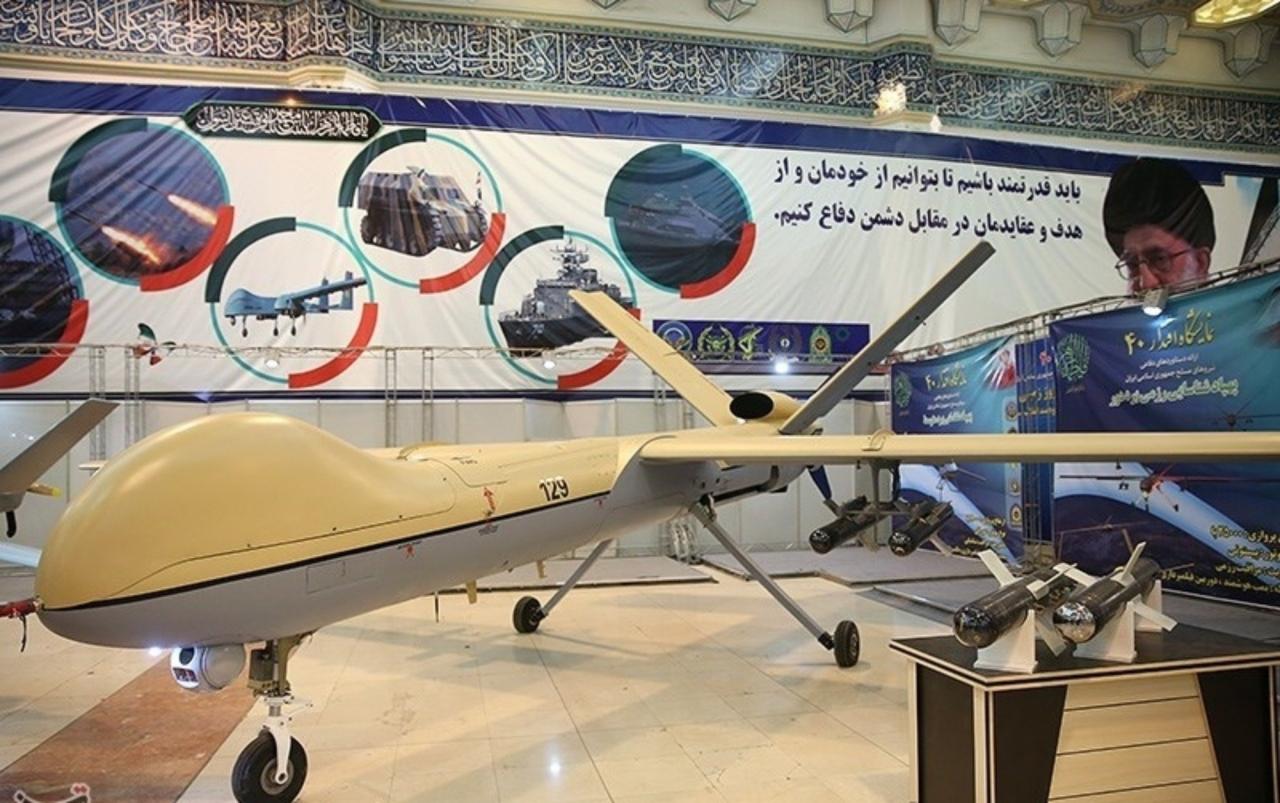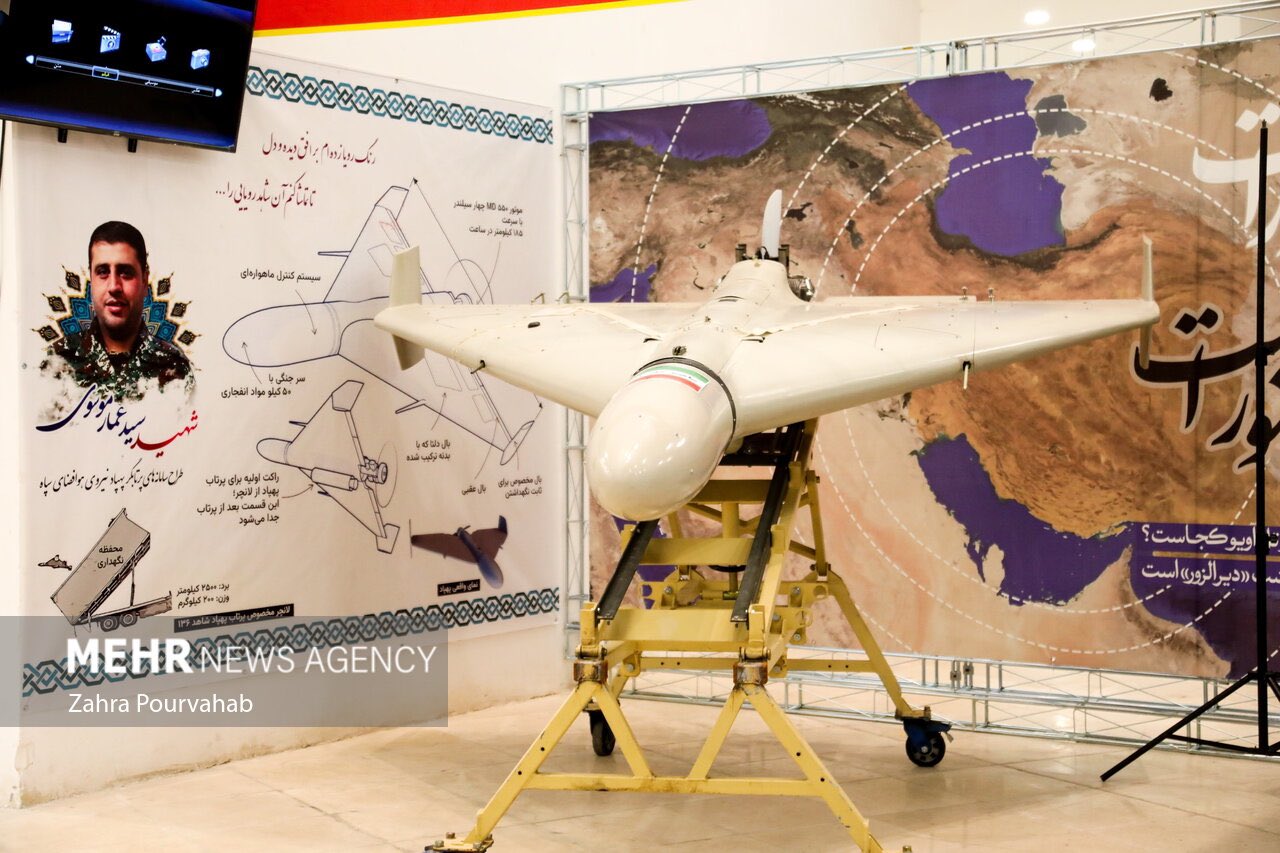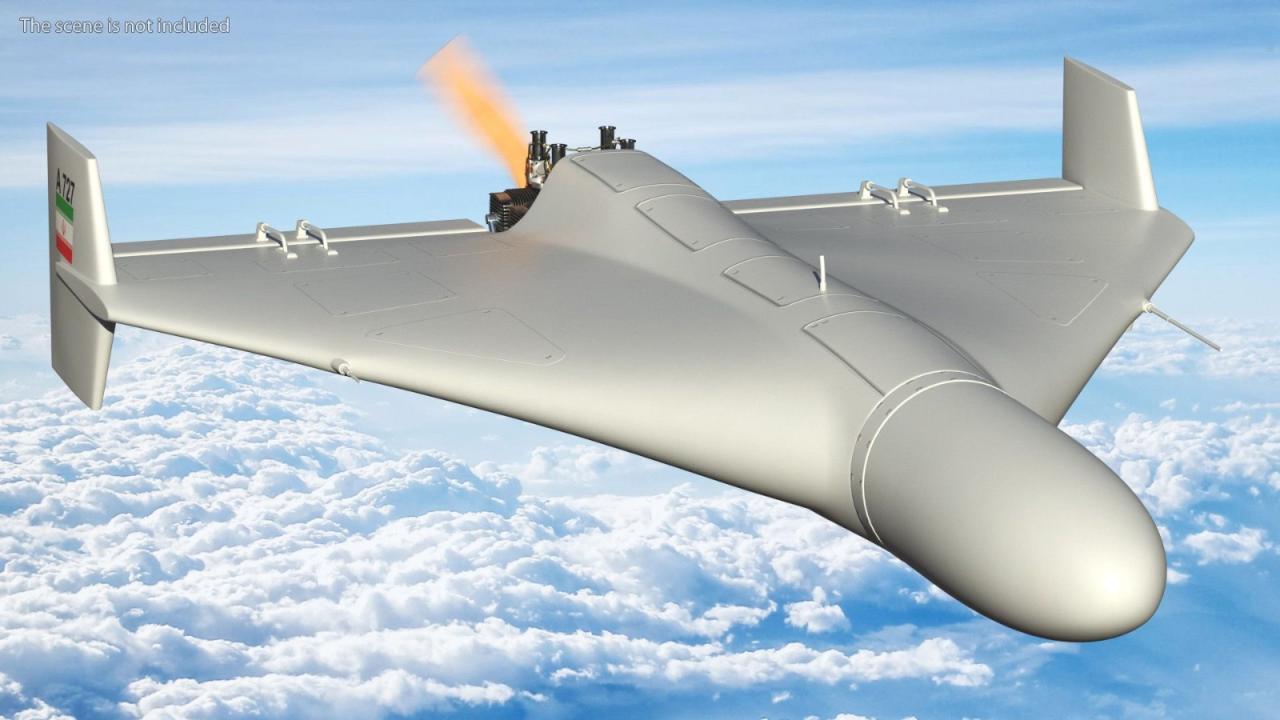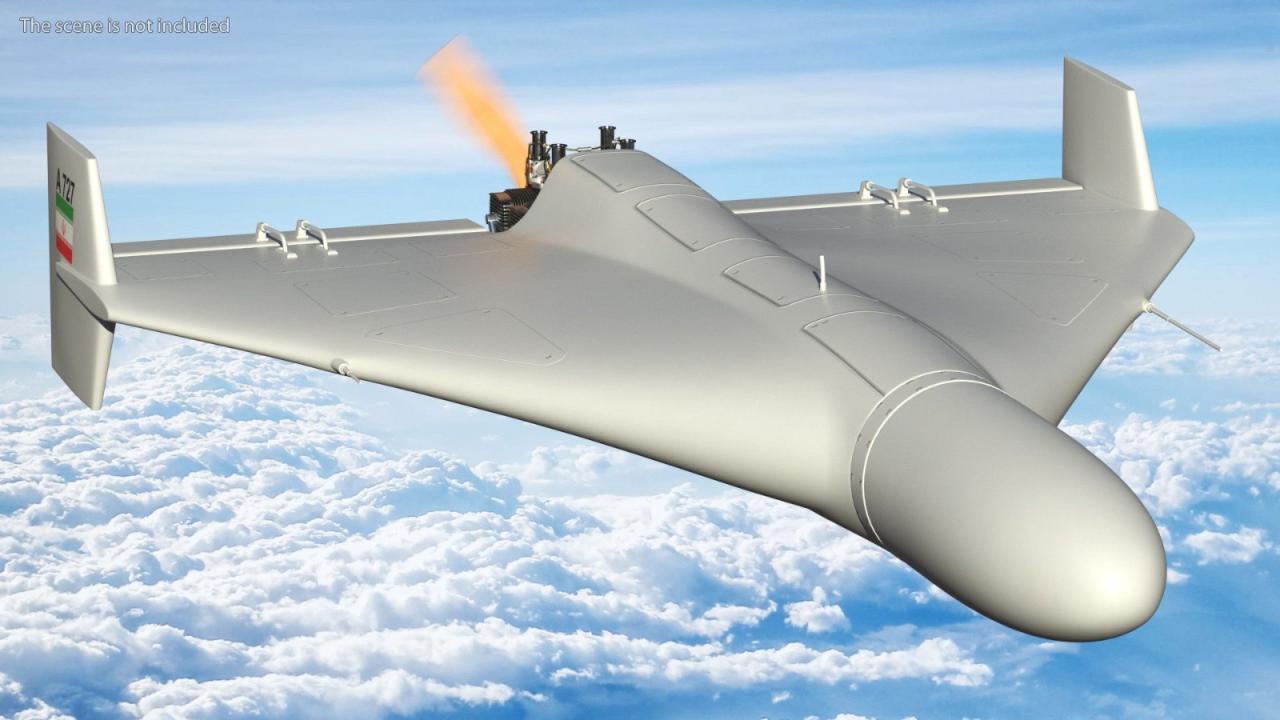Shahed drones have emerged as a significant player in modern conflict, sparking global concern and debate. Their relatively low cost, ease of production, and devastating potential have redefined asymmetric warfare. This exploration delves into the technical specifications, operational capabilities, manufacturing processes, deployment tactics, and the far-reaching consequences of this increasingly prevalent technology.
From their design and manufacturing origins to their tactical deployment and geopolitical implications, we will examine the Shahed drone’s impact on various conflict zones and analyze the countermeasures being developed to mitigate its threat. We will also consider the broader humanitarian and economic consequences of its proliferation.
Shahed Drone Technical Specifications
The Shahed drone series, also known as the Geran-2 in Russian service, represents a class of low-cost, loitering munitions. Understanding its technical specifications is crucial to assessing its capabilities and limitations.
Key Technical Specifications
The following table summarizes the key technical specifications of the Shahed-136 drone. Variations exist within the Shahed family, and these figures may represent averages or typical values.
| Specification | Value | Specification | Value |
|---|---|---|---|
| Wingspan | ~2.5 meters | Weight | ~200 kg |
| Length | ~3.5 meters | Payload Capacity | ~50 kg (warhead) |
| Range | ~2,500 km (reported, may vary) | Flight Duration | ~10 hours (reported, may vary) |
Propulsion System
The Shahed drone utilizes a small, relatively low-power internal combustion engine, likely a modified model of a commercially available engine. This contrasts with many other UAVs which employ electric motors powered by batteries. The use of an internal combustion engine allows for a longer range and endurance compared to battery-powered drones of similar size and weight, but it introduces increased noise and a more easily detectable heat signature.
Internal Components and Functionalities
A simplified schematic representation of the Shahed drone’s internal components would include the following:
1. Propulsion System: Internal combustion engine, fuel tank, propeller.
2. Navigation System: Inertial Navigation System (INS), GPS receiver (potentially augmented with other navigation aids).
3. Control System: Flight control computer, autopilot, communication module.
4. Warhead: High-explosive warhead, detonation system.
The Shahed drone, a relatively inexpensive unmanned aerial vehicle, has gained notoriety for its use in recent conflicts. Understanding its capabilities is crucial, and for more in-depth information on its design and operational aspects, you can refer to this comprehensive resource on the shahed drone. This resource provides valuable insights into the technology behind the Shahed drone and its implications for modern warfare.
5. Communication System: Radio transceiver for communication with the ground control station. This system may use frequency-hopping spread spectrum (FHSS) techniques to improve communication reliability and make detection more difficult.
Shahed Drone Operational Capabilities
The operational capabilities of the Shahed drone are a key factor in its effectiveness as a weapon system. These capabilities are closely tied to its technical specifications and design.
Navigation and Targeting
The Shahed drone’s navigation system relies primarily on GPS, though inertial navigation systems likely provide redundancy. Targeting is generally pre-programmed before launch, although some models may have limited mid-flight targeting capabilities. The warhead is typically detonated via proximity fuse or impact.
Mission Profiles
The Shahed drone is primarily employed in loitering attack missions against fixed targets, such as infrastructure or military installations. Its long range and endurance make it suitable for attacks against targets deep within enemy territory.
Comparison with Other Drones
Compared to other loitering munitions and attack drones, the Shahed drone distinguishes itself through its relatively low cost and ease of production, allowing for large-scale deployments. However, it sacrifices precision and sophisticated targeting capabilities compared to more advanced UAVs.
The Shahed drone’s impact on modern warfare is undeniable, raising concerns about its effectiveness and proliferation. Interestingly, the high-resolution images needed for detailed analysis of these drones are often captured using cameras like the fujifilm x100v , known for its exceptional image quality and compact size. This highlights the diverse applications of advanced imaging technology, even in the context of military analysis of the Shahed drone’s capabilities and vulnerabilities.
Shahed Drone Manufacturing and Production
The manufacturing process and supply chain of the Shahed drone are relatively straightforward, contributing to its low cost and mass production potential. This simplicity, however, also contributes to the ease with which it can be replicated and proliferated.
Production Stages
- Component sourcing: Procurement of engines, electronics, and other components, potentially from multiple international suppliers.
- Assembly: Assembly of the airframe, integration of the propulsion system, navigation system, and warhead.
- Testing: Pre-flight testing and calibration of the drone’s systems.
- Deployment: Transportation and deployment to operational areas.
Shahed Drone Deployment and Tactics
Shahed drones have been deployed in various conflicts, employing a range of tactics that leverage their capabilities and limitations.
Deployment Tactics

Common deployment tactics involve launching large swarms of drones, overwhelming defenses through sheer numbers. These attacks often target critical infrastructure or military assets.
Countermeasures Effectiveness
The effectiveness of countermeasures varies. While electronic warfare measures and air defense systems can be effective, the low cost and relatively simple design of the Shahed drone make it a challenging target to neutralize completely.
Significant Deployments

Significant deployments of Shahed drones have been documented in conflicts in Ukraine, Syria, and Yemen. A detailed timeline would require extensive research across multiple conflict zones and reporting sources.
Shahed Drone Impact and Consequences
The widespread use of Shahed drones has had significant humanitarian, geopolitical, and economic consequences.
Humanitarian Impact

Shahed drone attacks have resulted in civilian casualties and damage to civilian infrastructure. The indiscriminate nature of some attacks has raised serious concerns about the adherence to international humanitarian law.
Geopolitical Implications, Shahed drone
The proliferation of Shahed drones has shifted the balance of power in several regions, enabling non-state actors and smaller states to project power beyond their traditional capabilities.
Economic Consequences
The low cost of Shahed drones makes them accessible to a wider range of actors, potentially destabilizing regional economies and increasing the cost of conflict.
Shahed Drone Countermeasures and Defenses
A range of countermeasures and defensive strategies have been developed and deployed to mitigate the threat posed by Shahed drones.
Countermeasures and Effectiveness
| Countermeasure | Description | Effectiveness | Limitations |
|---|---|---|---|
| Electronic Warfare | Jamming GPS signals, disrupting communication links | Moderate to High (depending on the sophistication of the jamming system) | Susceptible to counter-jamming techniques; may have collateral effects on other systems |
| Air Defense Systems | Surface-to-air missiles, anti-aircraft artillery | High (against individual drones), but requires precise targeting | Costly, resource-intensive, less effective against swarms |
| Drone-Specific Countermeasures | Directed energy weapons, net guns, specialized anti-drone systems | Variable, highly dependent on technology | Limited range, effectiveness may vary depending on drone design |
Technology Applications
Electronic warfare systems play a crucial role in disrupting Shahed drone operations by interfering with their navigation and communication systems. Air defense systems, though more expensive, offer a more direct means of neutralizing the threat. Emerging technologies, such as directed energy weapons, are showing promise in countering swarms of low-cost drones.
Engagement Process
A typical engagement scenario might involve detection of the Shahed drone via radar or other sensors, followed by targeting and engagement by an appropriate countermeasure system. The effectiveness of the countermeasure would depend on factors such as the range, accuracy, and capabilities of the system used, as well as the drone’s evasive maneuvers.
The Shahed drone represents a paradigm shift in military technology, highlighting the accessibility of advanced weaponry and its profound implications for global security. Understanding its capabilities, limitations, and the strategies employed to counter its use is crucial for navigating the evolving landscape of modern warfare. Further research and international cooperation are essential to mitigating the risks associated with this technology and preventing its further proliferation.
Commonly Asked Questions
What is the lifespan of a Shahed drone?
The operational lifespan varies depending on usage and maintenance, but it’s generally considered to be relatively short compared to more sophisticated drones.
How accurate are Shahed drones’ targeting systems?
Accuracy is a subject of ongoing debate and analysis, with reports suggesting varying degrees of precision depending on the specific model and operational conditions.
What are the main components sourced from outside Iran for Shahed drone production?
Precise details on the supply chain are often unclear due to secrecy and sanctions, but reports suggest various components originate from several countries.
Are there any limitations to the Shahed drone’s operational range?
Yes, range is limited by fuel capacity and other factors. This limitation influences deployment strategies and tactics.
